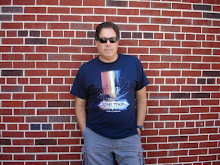
(October 1929, U.S.)
Alfred Hitchcock was unquestionably one of the greatest film directors that ever lived. His name is synonomous with films like PSYCHO, THE BIRDS, REAR WINDOW and VERTIGO. It's also important to remember that before he made his first film in America in 1940, he had an 18 year career of silent and sound films in Great Britian. This part of his career gave us films like THE 39 STEPS (1935), THE LADY VANISHES (1938) and the original version of THE MAN WHO KNEW TOO MUCH (1934).
So now lets talk about BLACKMAIL. This is an odd film because the first eight minutes of it plays as a silent film before eventually turning to sound. The film began production as a silent film, but in order to cash in on the new found popularity of "talkies", the film's producer gave Hitchcock the go-ahead to film a portion of the movie in sound. Hitchcock thought the idea absurd and surreptitiously filmed almost the entire feature in sound along with a silent version for theatres not yet equipped for talking pictures (you have to admire that kind of artistic stubbornness, right?). Even in his earliest work, Hitchcock manages to make a film filled with the kind of story twists that define his genre. The detective hero of Scotland Yard must protect his girlfriend whom he knows to be guilty of murdering her would-be attacker in self defense. He must also protect her from the petty, sleazy witness who found her glove at the scene of the crime who now wants to extort money from the both of them in exchange for his silence. In an interesting twist, there was another witness who saw the blackmailer at the scene of the crime, as well, and now Scotland Yard is looking for HIM instead of the girlfriend he seeks to blackmail.
(take a deep breath and then take all of that in for a moment)
In a modern film, the subject of attempted rape and murder with a knife would be shown in much more graphic detail. In 1929, though, that would have been forbidden. So Hitchcock effectively only shows us the large curtain where all of this is taking place. The woman is being attacked and we only see her hand from behind the curtain reach for the nearby knife and stab her attacker to death. After that, we only see his dead hand appear from the curtain. What follows this is her eerie and almost catatonic exit from the crime scene. She is mortified over what she's just done and she can't help but think she sees the dead man's hand and knives everywhere when she walks the streets of London afterwards. It's pure Hitchcock suspense, even in its earliest stages.
Alfred Hitchcock's cameo, a signature occurrence in many of his films, shows him being bothered by a small boy as he reads a book on the London Underground. This is probably the lengthiest cameo appearance he ever performed in his film career. As he became better-known to audiences, especially when he appeared as the host of his own television series, he dramatically shortened his on-screen appearances.
Favorite line or dialogue:
Det. Frank Webber: "You haven't seen "Finger Prints." I'd like to see that. Uh, still, it's about Scotland Yard. Might be amusing. They're bound to get all the details wrong."
Alice White: "I don't see why. I did hear they got a real criminal to direct it, so as to be on the safe side."


No comments:
Post a Comment